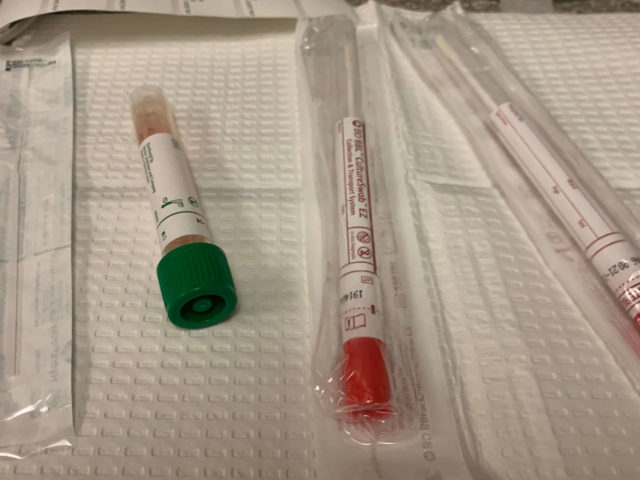He started feeling miserable in mid-March.
Cough, fever. Slept all day. Then he felt better for a few days, even went back to work as a service adviser at a car dealership. Then he took another turn for the worse, and went to the doctor — but despite the global pandemic that fit all his symptoms, he couldn’t get tested.
“It was state-ordered, as far as what (my doctor) told me, that they would toss whatever samples came in that weren’t from (someone) being hospitalized,” the Oconomowoc man said in an interview. At 42, he wasn’t in a high-risk category, and wasn’t sick enough to require a ventilator. “I was very frustrated. My work wanted to know because I think they were going to shut down if I did have it,” he said.
A coworker came down with all the same symptoms and couldn’t get tested either. And without a positive diagnosis, the dealership didn’t shut down. Still, the man, who asked not to be identified to protect his health care privacy, was laid off, along with about half of the dealership’s staff.
Just a couple weeks after he got sick, a woman in Madison got tested, though she’d never shown a single symptom. A type I diabetic, she’d had cataract surgery and needed a follow-up procedure to repair a burst blood vessel in one eye.
“They made me go in for a pre-op physical, just to make sure everything was fine with me and I was okay to have surgery. And I thought that was it,” she said. “And then the week of the surgery on the Monday they called me and were just kind of like, because of everything that’s going on, one of their new policies is that anybody that’s having surgery needs to be tested for COVID-19.”
She had to trek all the way to Middleton from her home on Madison’s east side, and got a drive-through test. She was negative, and the eye surgery went just fine.
Stories like these — people clearly ill who don’t get tested and people who are clearly fine who do — have been happening across the country even as local health officials and state leaders clamor for more testing as the best means to get the novel coronavirus under control.
As of Thursday, Wisconsin Department of Health Services Secretary-Designee Andrea Palm said the state has almost 50 labs ready to process more than 10,000 tests a day, well on the way to Governor Tony Evers’ stated goal of testing 12,000 people every day.
Yet statewide, only between 1,500 and 1,800 people are being tested every day.
So what’s going on here?
Local health providers say that’s a more complicated question than it might seem.
Every virus has its own genetic signature, and therefore requires its own test. Usually, providers can just stock up for flu season.
“Everyone knows when influenza season is, and they make sure that their supply is adequately prepared. This came out of the blue,” said Dr. Jeffery Pothop, chief quality officer at UW Health.
“The first six weeks or so of this pandemic have been marked, as we’ve all seen everywhere, by shortages and runs on supplies because things were unanticipated and everybody’s competing for the same supplies,” said Group Health Cooperative Chief Medical Officer Dr. Chris Kastman. “There’s a whole chain of things that need to be available to do testing in bulk. It’s a mobilization effort as much as anything.”

Pothof said medical supply vendors did a pretty good job of getting a test developed quickly, but they still needed time to manufacture the testing materials, which include both swabs and reagents, the chemicals used to extract the genetic material from the viruses for testing purposes.
“I get the struggle of a test that didn’t exist, to a test that needed to exist, and is now the most popular test in the world. That’s a challenge,” Pothof said. “Companies would allow you to order maybe a huge supply, but then they’d say, ‘You know what? We don’t have quite that much. We can send you X amount.’ And then when you actually got your shipment, it was one-third of what X was. So there was great uncertainty.”
“We even have some of those machines and we could theoretically do rapid testing,” Kastman said. “But in that case, the reagents are on backorder until kingdom come. There’s no estimated ship date. Somebody’s got them. And so the supply chain is just backed up.”

Pothof said early on, the origin of the materials exacerbated the delays.
“Everybody wanted (the testing supplies), everyone tried to get them, and there just wasn’t enough,” he said. “And it wasn’t even just us, it was the rest of the world. And I think one of the things that we talked about early on is a lot of this stuff is made in China. And when we first got going on this, China was making nothing. They were completely shut down. So a lot of our vendors, their suppliers are in China and they couldn’t even get product because all those factories in China were shut down.”
And there wasn’t much the government could do to help, either. The Strategic National Stockpile of medical supplies was designed to support local providers in a natural disaster or similar event, not a pandemic. While it was able to help a bit with PPE and ventilators, it wasn’t much use for testing supplies.
“Clearly people would be thinking, ‘In a disaster we need ventilators, we need PPE.’ And I’m doubtful that people were like, ‘In a disaster, we would need cotton swabs you stick up in your nose,'” Pothof said.
To make matters worse, given how contagious the virus is, testing materials weren’t the only issue.
Even if a clinic or hospital has all the testing supplies and a lab ready to process the tests, Pothof said, “well that’s great, but you have to have a place where you can actually collect that sample … someone still needs to figure out how to collect that specimen, and then you can have the PPE available to be able to collect the specimen.”
Both UW Health and GHC had to restructure their clinics to isolate all coronavirus testing in a single location, for example, which was logistically difficult and expensive.
And even if a provider was able to collect a sample, getting it to a lab wasn’t always easy, especially early on when there was only one lab in Wisconsin capable of processing the coronavirus test.
“If you’re in the northern part of the state, you probably don’t have a lab anywhere close by that does this test,” Pothof said. “So now there’s this transportation issue of if I’m in Northern Wisconsin, and I test someone for COVID-19, I probably have to ship that test hours away to get that result. And now there’s that delay in things coming back, which makes testing somewhat complicated.”
As a result of all of those challenges, providers initially were very selective in who got tested.
That might be changing soon, however.
“I think that the supplies chains are starting to open up and we hope to be able to offer testing to anybody who is even mildly ill,” Kastman said.
“I’d say over the last several weeks (supplies have) shored up quite a bit,” Pothof said.
The State Department of Health Services has relaxed guidelines on who should get tested, and both Pothof and Kastman said they anticipate mildly ill people getting tested soon — but don’t expect getting tested to necessarily benefit you if you have a mild case.
“There’s no evidence-based intervention at this point. There are no medicines to help them, even if we identify people early,” Kastman said. “But it will probably allow for smarter quarantining and contact notification. From a public health level, it could be useful to know who’s got it, even if they’ve only got a cold, basically, and really make sure that they limit their contacts or eliminate contacts.”
Kastman said he expects more people to be willing to come to clinics to be tested as a sense of “panic” dies down.
Expense might be another barrier for some. Health insurance plans are covering the tests for the most part, though local governments have had to commit to testing the uninsured. Members of the National Guard are preparing to begin testing those populations at an alternative care facility near Alliant Energy Center soon.
“The officials are doing a good job at thinking those scenarios through,” Kastman said.
Kastman said that even though more people can get tested now, you should still call ahead.
“What we really don’t have the infrastructure for is that we can’t have everyone who wants a test to be like, ‘Well, I’ll just go to the urgent care or the (emergency room) to get it,’” he said. “One, we don’t have that many tests at urgent care and (the emergency room). Two, that’s probably the worst place to go to get a test right now if you’re otherwise doing pretty well.”




























